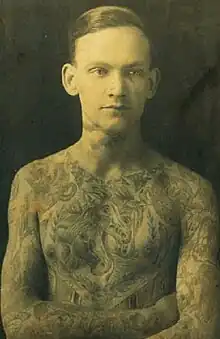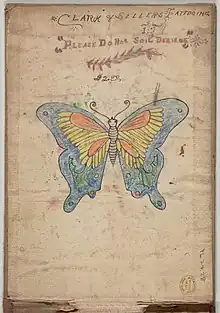American traditional
American traditional, Western traditional or simply traditional[1]: 18 is a tattoo style featuring bold black outlines and a limited color palette, with common motifs influenced by sailor tattoos.[2] The style is sometimes called old school and contrasted with "new school" tattoos, which it influenced, and which use a wider range of colors, shading, and subjects.[1]: 61

Old school tattoo designs on tattoo artist Amund Dietzel
Artists
- Norman Keith Collins, also known as Sailor Jerry, (1911–1973) was one of the most well-known traditional tattoo artists.[4]
- Herbert Hoffmann (1919–2010), began tattooing in Germany during the 1930s. Together with fellow artists Karlmann Richter and Albert Cornelissen, he was featured in the 2004 film Blue Skin (German: Flammend' Herz).
- Amund Dietzel (1890–1974), Norwegian-born artist who began his career as a sailor, before settling in the United States. Known as the "Master in Milwaukee".
- Bert Grimm (1900–1985). Began his career in the city of St. Louis and then moved to Long Beach, California, to set up a shop at the Nu-Pike. His parlour was said to be the oldest continually running in the continental US and the place for sailors to get inked. Grimm sold the shop to Bob Shaw in 1970.
- Bob Shaw (1926–1993), American artist who learned tattooing from Bert Grimm in St. Louis. Later worked with Grimm and became the president of the National Tattoo Association from 1983–1988.[5]
Common motifs
.jpg.webp)
Tattoo design with a naval theme, circa 1900–1945
Many old school motifs derive from tattoos popular among military service members, including patriotic symbols, such as eagles and American flags, along with pin-up girls.[2]
Other old school tattoo designs include:
- Mermaid
- Swallow (sometimes confused with sparrows and bluebirds)
- Heart
- Anchor
- Eagle
- Panther
- Snake
- Luck (black cats, 13, four-leaf clover, horseshoe, etc.)
- Navy and sailing symbols
- Dagger
- Rose
- Nautical star
Examples
Designs circa 1900–1945 by Clark & Sellers:
 Ship
Ship "In memory of my mother"
"In memory of my mother" Performer
Performer Army nurse
Army nurse Anchor with heart and rose
Anchor with heart and rose Madonna and child
Madonna and child_MET_DP836708.jpg.webp) Dragon and snake
Dragon and snake Woman representing "America"
Woman representing "America" Butterfly
Butterfly
References
- Miller, Jean-Chris (1997). The body art book: a complete, illustrated guide to tattoos, piercings, and other body modifications (Berkley trade pbk. ed.). New York: Berkley Books. ISBN 042515985X.
- Festa, Joe (2013-02-06). "A Short, Incomplete History of American Traditional Tattooing | New-York Historical Society". New York Historical Society. Retrieved 2022-06-04.
- Michalak, Jodie (February 18, 2022). "Flash vs. Custom Tattoos". Byrdie. Retrieved 2022-06-05.
- JP (2009-01-29). "The Legend of Sailor Jerry | Tattoo Master Norman Collins". The Selvedge Yard. Retrieved 2022-06-04.
- Clerk, Carol (2009), Vintage Tattoos - The Book of Old-School Skin Art, Universe, pp 12-15.
External links
- Old School tattoo gallery Archived 2016-06-21 at the Wayback Machine on BME zine
This article is issued from Wikipedia. The text is licensed under Creative Commons - Attribution - Sharealike. Additional terms may apply for the media files.